June 19, 2015
Forty years later: the book jacket for “Jaws”
by Kirsten Reach
 “First novels generally sink, and this was a first novel about a fish,” author Peter Benchley said of his novel Jaws, in a 1991 interview with the Palm Beach Post. “They couldn’t make a movie out of it, because they’d never be able to train a great white shark to do all those things.”
“First novels generally sink, and this was a first novel about a fish,” author Peter Benchley said of his novel Jaws, in a 1991 interview with the Palm Beach Post. “They couldn’t make a movie out of it, because they’d never be able to train a great white shark to do all those things.”
“They” did make a movie, forty years ago this weekend, and by the author’s count, the book sold 4.5 million before the film, plus 4.5 million after it. The Palm Beach Post reran their interview with the author yesterday in honor of the anniversary.
Benchley says, “Everything about it was an accident.” He received $1,000 of his $6K advance from Doubleday to write the novel. His editor was Tom Congdon. The author knew Southampton, Long Island well after writing an article about it for a magazine piece, so he fictionalized the town as Amityville. He’d read about a Great White Shark caught off of Long Island that was 4,500 pounds, and thus Jaws was born.
Other titles the author and editor discussed include Leviathan Rising, The Stillness in the Water, The Jaws of Leviathan, and The Jaws of Death. When Benchley suggested Jaws, after an estimated 125 ideas, Congdon asked what it meant. “I don’t know, but it’s short; it fits on a jacket, and it may work,” he said. (Our system for generating ideas for book titles has not changed much since 1947.) Bantam editor Oscar Dystel famously quipped that “it could have been a title about dentistry.”
After publication, the book took on a life of its own, the author says:
In 1975, Fidel Castro was asked in an interview what he was reading and he said, “Jaws. It’s a marvelous metaphor about the corruption of capitalism.” I’ve heard it said that Jaws is Watergate, and the shark is Nixon. I’ve had gay rights groups say it’s about three men bonding on a boat. People attribute a great many more things to the book than I meant.
The design for the Universal Studios movie poster is taken from the Bantam paperback edition by Robert Kastel. But the hardcover image belonged to artist Paul Bacon. And before that, illustrator Wendell Minor came up with the first sketches. He was out of town when Doubleday decided they needed to revise. Bacon came up with the shark head, and the design director suggested adding a swimmer “for scale.”
Gizmodo reports:
Though the cover concept was born in Doubleday’s New York City offices in 1974, it was not the publisher’s first instinct for Benchley’s novel. Instead, Doubleday’s design director, Alex Gottfried, asked book illustrator Wendell Minor to depict Amity as seen through the jaws of a shark.
“I did a painting looking straight at the shark’s open mouth, with this seaside village in the distance,” Minor recalls. “I wasn’t all that thrilled about the concept, I didn’t think it worked, but that was the direction they wanted me to go in.”
As Kastel remembers it, Dystel was not a fan of the Doubleday cover and wanted Kastel to look at the cover with fresh eyes. “He wanted me to read the book to pick out a new part to illustrate. But, of course, the best part was the beginning, where Chrissie goes into the water nude.” Turns out the Doubleday concept, if not the execution, was not so bad after all. Kastel did a sketch for Dystel and Leone to critique. “The only direction Oscar and Len gave me was to make the shark bigger, and very realistic.”
By all accounts Kastel succeeded, although the graphic nature of Kastel’s image (its nudity, not the impending violence) got the paperback banned in Boston, Massachusetts, and St. Petersburg, Florida. “I thought that was the end of my illustration career,” Kastel says. “Boy was I ever wrong. Bantam loved the publicity. It was great for book sales.”
Here are subsequent editions of Jaws:
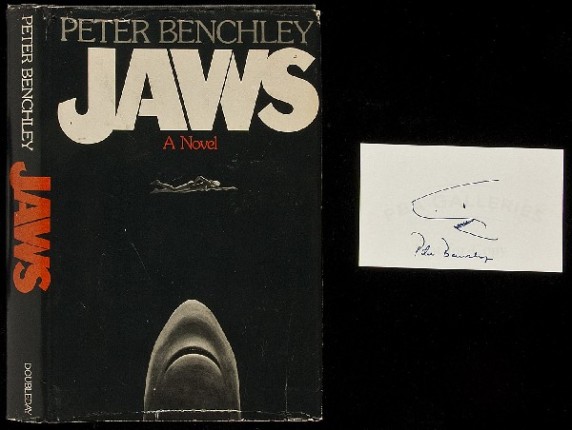
The first hardcover edition, designed by artist Paul Bacon (with a cartoon by the author).
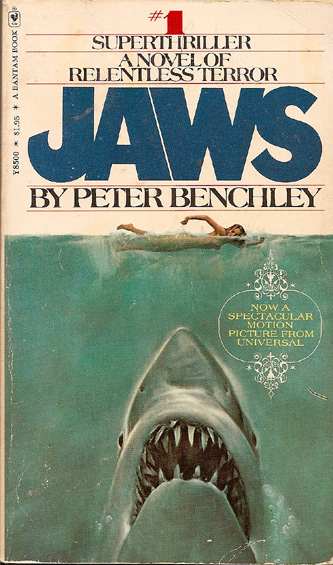
Bantam was convinced the approach was not right. They called in Roger Kastel to create a striking image for the paperback. He followed the general direction of the hardcover, but he studied Great Whites at the American Museum of Natural History and used a real model (posed on a stool in a swimming position) to come up with this image, now famously on the Universal Studios poster.

The trade paperback image morphed into the Universal Studios movie poster.
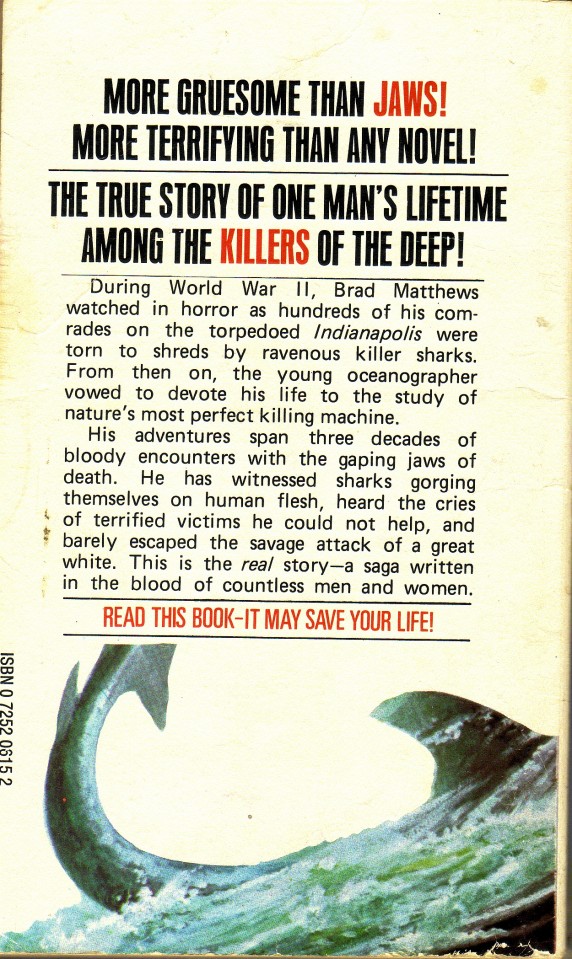
Publishers raced to follow the success of “Jaws” with similar thrillers. This is the back cover of a book by Brad Matthews published almost immediately after the rush for “Jaws.”
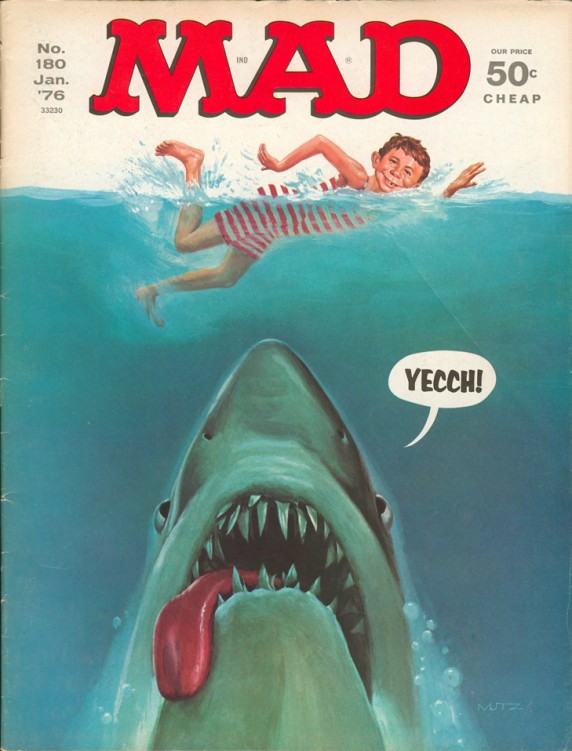
Mad Magazine even borrowed the cover image in 1976.

Jaws 2: Now with more teeth.
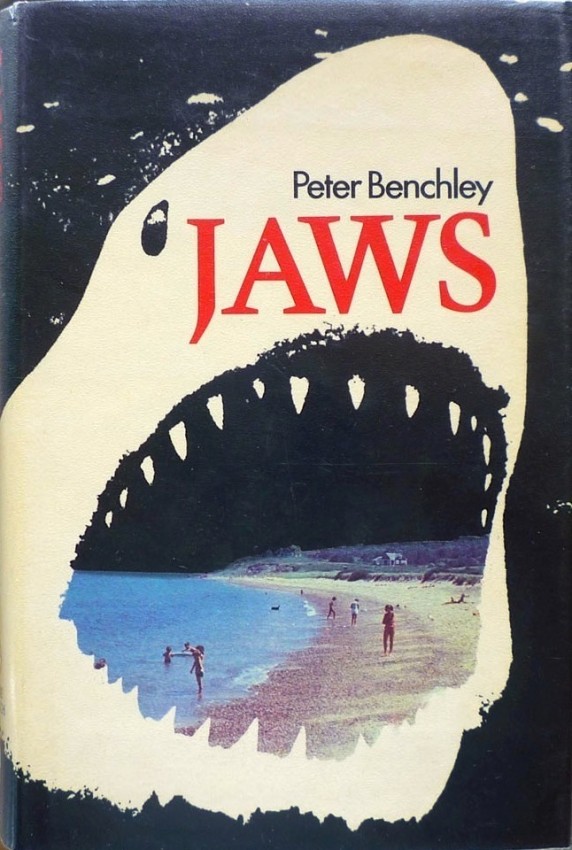
In some editions, the shark has swallowed a whole beach.

Just a friendly photo of the author with a shark from People Magazine, 1974.

And the image grew larger (with more sharp teeth) in each subsequent book.
Kirsten Reach is an editor at Melville House.